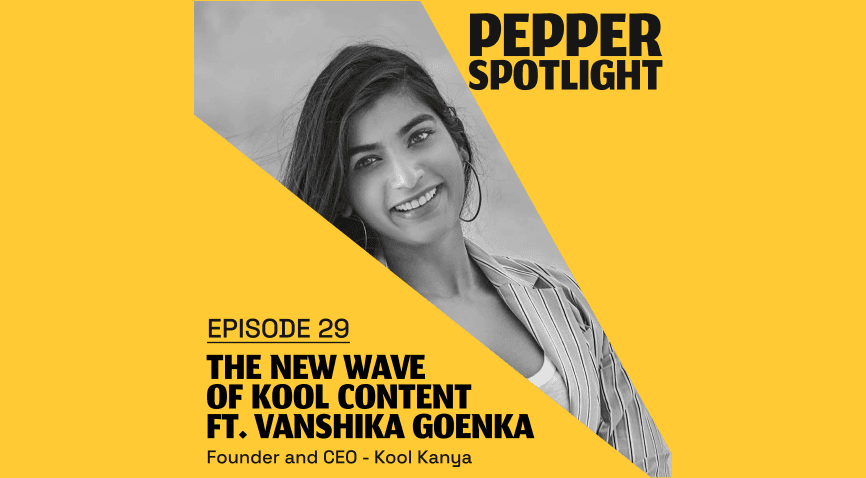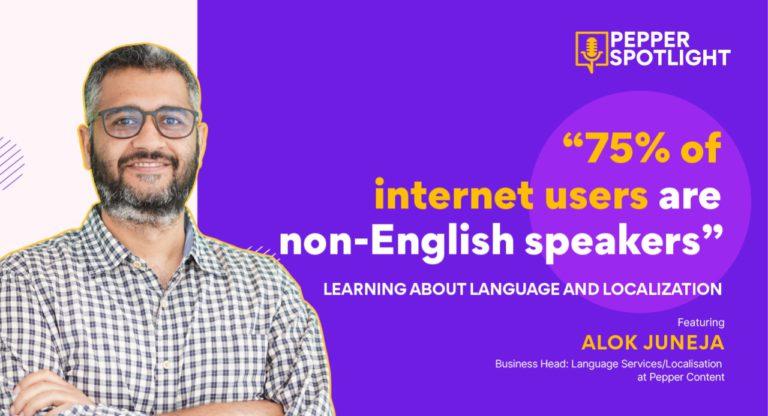The New Wave Of Kool Content Ft. Vanshika Goenka | Pepper Spotlight Ep. 29

Men or women, we are not very different as humans. But we like our little clubs where we thrive. Be it a boys club, a women-only salon, a women’s only hospital. These segregations create a safer and cozier space for women (and men) the world over.
One such incredible platform is KoolKanya. Today they focus on creating workshops on a subscription model to help women achieve their dreams. They started as a content resource for women and soon warped into its many avatars.
Vanshika Goenka, the Founder of KoolKanya, was our guest on the Pepper Spotlight Podcast. We chatted about creating women-centric content, the many stages of KoolKanya, and much more.
You can check out the whole show here:
A few highlights from this show are here below:
From Family Businesses; to a Business like Family
An Indian household teaches you more life lessons than any school can. And this was especially true for the Vanshika, who grew up in a Marwari family that lived business each day at home. She was once, as a teenager, told, “Every dinner conversation you had has been a training ground.”
Growing up with a dad who runs a business, you often face new experiences within the walls of your home. You can learn about how running a business means everything is your call. If right or wrong — the credit is yours. And when things work in favor of the company, there is nothing more rewarding.
Vanshik also worked with a sanitary pad company that had more men than women at the workplace. The dichotomy of the situation made her question the representation of women in everyday roles.
As a first step towards this change, Vansika created a blog highlighting and providing helpful resources for women. Be it maternity information or women at the workplace — there was a lot to talk about.
“One word that can explain us is Pivot,” said Vanshika. From a blog to a community, to a freelancing network and now a provider of workshops — KoolKanya manages pivots at all the right chances.
“As COVID hit we started creating communities and started the freelancing network,” she explains. “Now, we focus on workshops to help young women.”
The Subscription Model and Indians
“It’s still a lot of learning,” was Vanshik’s short answer. Indian is still at the nascent stages of a subscription boom. Other than OTT platforms, few can capitalize on this market as well.
Vanshika and KoolKanya have one significant problem when rolling out subscription models in India.
Firstly, A lot of the audience are young people who do not own credit cards. It’s hard to build a base of users when you must depend on monthly payments or renewals. As India is not yet a credit-card market, this challenge is a massive roadblock.
KoolKanya takes a month-long payment and then uses content to help them come back for a second. Another alternative is using a one-time fee, but that increases the course cost and sometimes makes it unaffordable.
The way to sell to Indians, as explained by Vanshika: “We order a taster. and then buy.” Using this approach, KoolKanya gives away small courses to the users as a hook to their larger courses.
Promote With with Content
Like most brands on the internet today, KooKanya also buckets their content based on the audience’s reactions. It’s common practice to feed your audiences with more of what they like or what they ask.
KoolKanya depends on its community to test content. They then move the test model to the real world as promotional content. “One thing to realize is – what the user likes and does not!” She said,
Ask the users what they are looking for and add programs, courses, and subscriptions as you see a demand. “Feedback might not work, but a phone call will work!” Vanshika assures.
The Team Behind It
What does it take from a team to flawlessly manage so many moving parts? As KoolKanya makes its leaps and impressions along many avenues — how does a team keep up with this?
The answer: Be agile!
Vanshika believes in showing the team numbers to back her claims. Data allows the team to buy a news idea and back it as much as the founders. These numbers and data are one of the best ways to promote actions.
Secondly, KoolKanya believes in the “all hands on deck” approach. The whole team here works as one cohesive unit. “See the situation and pick your approach,” said Vanshika, “The focus of a common vision helps a lot.”
Advantages and Disadvantages of A Women-only Audience.
Running a business that caters to just one niche audience cannot be easy. But what are the benefits and drawbacks of this approach?
According to Vanshika, the one apparent disadvantage is that the user base is cut in half before they even start a business. This makes your niche really narrow and sets roadblocks from the get-go. However, this is a change that’s easy to adapt to.
The advantage is, in her words, knowing exactly what you want. For example, now KoolKnaya focuses on beginners in the business world. “Before the content would go to everything from school to maternity,” she said, “having this focus helps us make better content for Instagram, blogs, and whatnot.”
In Closing,
Check out the entire episode of this conversation with Vanshika to learn more about time management, creators to look out for, and the current trends in the freelancing market. It’s a show packed with entertainment and insight.
Latest Blogs
Explore how Google’s 2025 AI search updates triggered ranking chaos. Learn actionable strategies to adapt your SEO for AI Overviews, zero-click searches, and SERP volatility. Stay ahead now.
Learn how to rank on AI search engines like ChatGPT, Perplexity, and Gemini by optimizing your content for authority, structure, and relevance. Stay ahead in AI-driven search with this strategic guide.
Explore the best healthcare SEO services for your medical practice. Improve online visibility and effectively reach more patients in need of your services.
Get your hands on the latest news!
Similar Posts

Pepper SPOTLIGHT
3 mins read
Learning About Language and Localization Podcast with Alok Juneja: Pepper Spotlight

Content
7 mins read
What Marie Kondo Can Teach You About Writing Better

Email Marketing
8 mins read